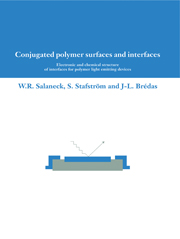 Conjugated Polymer Surfaces and Interfaces
Conjugated Polymer Surfaces and Interfaces Published online by Cambridge University Press: 12 January 2010
In this section, the basic features of light absorption and emission (luminescence) processes in conjugated systems are reviewed. The discussion will focus on poly (p-phenylenevinylene), PPV, compounds, which provide typical examples of the physical phenomena to be highlighted in the context of polymer-based light emitting devices.
Optical absorption
In most cases, conjugated polymers present broad, inhomogeneous optical absorption bands that become more resolved when the material can be prepared in a more ordered way. This broadness originates in a number of features such as distribution of chain lengths, presence of chain bends, chain twists, or other defects, which contribute to the determination of an effective conjugation length. In the best-ordered PPV samples, the extent of effective conjugation length is estimated to be on the order of 15–20 phenylene vinylene units, by making comparison among a series of well-defined phenylene vinylene oligomers and PPV-based polymers.
Another most notable aspect relates to the vibronic coupling, that is the coupling between electronic excitations and vibrational modes. As has been stressed many times in the literature, much of the rich and fascinating physics of conjugated polymers is based on the strong connection between the electronic structure and the geometric structure: any electronic process (be it photoexcitation or charge transfer upon reduction, oxidation, or protonation i.e., doping, of the polymer chains) results in significant geometry relaxations that in turn modify the electronic properties.
To save this book to your Kindle, first ensure [email protected] is added to your Approved Personal Document E-mail List under your Personal Document Settings on the Manage Your Content and Devices page of your Amazon account. Then enter the ‘name’ part of your Kindle email address below. Find out more about saving to your Kindle.
Note you can select to save to either the @free.kindle.com or @kindle.com variations. ‘@free.kindle.com’ emails are free but can only be saved to your device when it is connected to wi-fi. ‘@kindle.com’ emails can be delivered even when you are not connected to wi-fi, but note that service fees apply.
Find out more about the Kindle Personal Document Service.
To save content items to your account, please confirm that you agree to abide by our usage policies. If this is the first time you use this feature, you will be asked to authorise Cambridge Core to connect with your account. Find out more about saving content to Dropbox.
To save content items to your account, please confirm that you agree to abide by our usage policies. If this is the first time you use this feature, you will be asked to authorise Cambridge Core to connect with your account. Find out more about saving content to Google Drive.